In this brand new column ’Tested by our technician’ audio experts of Tau Audio Solutions are testing and review different products and solutions.
The brand Bodet Time is well known for its clocks and time synchronization systems who are used for, among other things, work and class signalling. This edtions we have extensively examined two time signalling systems of Bodet Time.
Time signalling system 1

The first system we have tested consists of:
- A Sigma-C master clock
- Melodys wireless loudspeaker
- Melodys wireless flash
- Wireless relais
- DHF digital LCD clock
- Melodys control box
Sigma-C master clock with DHF-transmitter
The heart of time signalling systems is the master clock and it’s controlling all the devices with the DHF transmitter. DHF is a protocol that wireless transmits a complete time code. Depending on the circumstances, the range of the transmitter is between 100 to 1000 meters. By using repeaters the rang can be increased. The transmission power and channel of the DHF transmitter is easy to set on the master clock.
DHF LCD clock
The LCD clock synchronizes with the master clock in a few seconds. The master clock has also a setting so each new clock in the network automatically synchronizes; this feature makes installing clocks in a building very easy. This mode exits automatically within a few hours. The digital LCD clock we have tested comes from the Opalys series from Bodet and works on batteries. The analogue clocks from Bodet Time runs on batteries or on an external power supply. LCD clocks with back light and Bodet’s LED clocks runs on 230V.
Different types of the Sigma master clocks
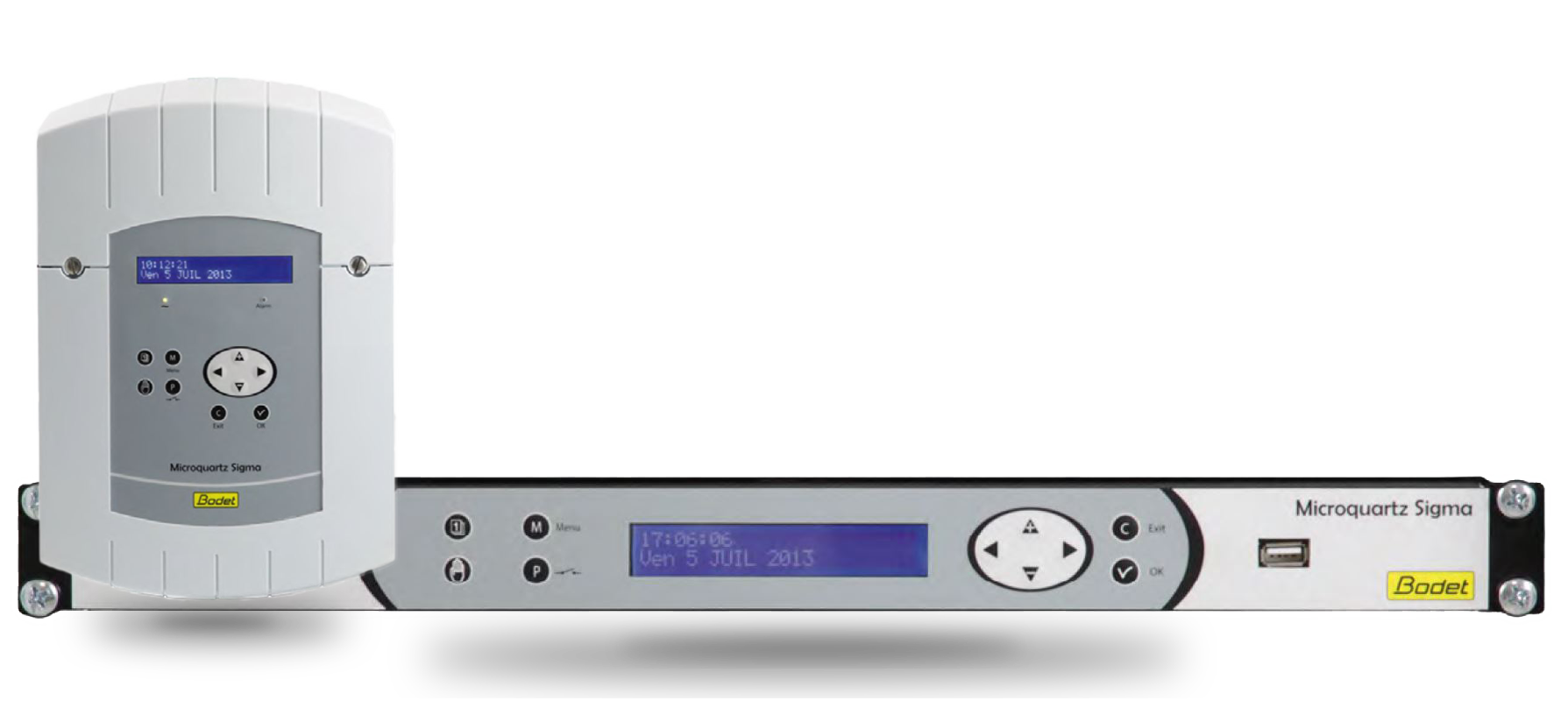
The tested Sigma-C master clock is a wall-mounted version and it’s made of a sturdy plastic wall housing. A rackmount version is also available for each type of master clock. A total of four different master clocks models available, each with their own communication options. The clock has a quartz oscillator that is stable up to 0.1 seconds per day. This is sufficient for many applications. The master clock can be synchronized by a DCF77 receiver, a GPS receiver or via an NTP server on the internet. changeover to summer and winter time is fully automatic.
The master clocks, equipped with a network connection (C and MOD), are programmed through the network. The other types of master clocks (P and H) will be programmed with an USB-stick.
User-friendly operation and programming
The master clock is operated via the SIGMA software. And this is a bit of an odd one. The Melodys loudspeakers and flashes can be divided into 16 zones. The relays are having a different (second) programming. By default, the (daily / weekly) program set which is active throughout the year. The second step is adding the holidays which have their own program, it’s usually empty. The holidays are already pre-programmed in a list which can be adjusted or added by yourself. In addition, the standard program can be replaced by an another program on certain days or times or supplemented with a specific program. For example in schools at ten minutes of conversations. On a certain date from a certain time to a certain time, are programmed in seconds. A relief compared to ordinary clocks or other time systems.
The Sigma software has an Outlook-like appearance, which immediately appears familiar. For each event you can choose which of the messages should be played. These messages are located in the internal memory of the Melodys speaker. The messages can be replaced by own sounds / messages via an SD card. It is also possible to play messages from the SD card.
Melodys and loudspeakersThis speaker sounds pretty good and also goes loud, the buzzers and messages are easy to understand. All they need is a wall socket. The Melodys loudspeakers are also available in a ceiling model, an outdoor model and a high power (horn loudspeaker) outdoor model. |
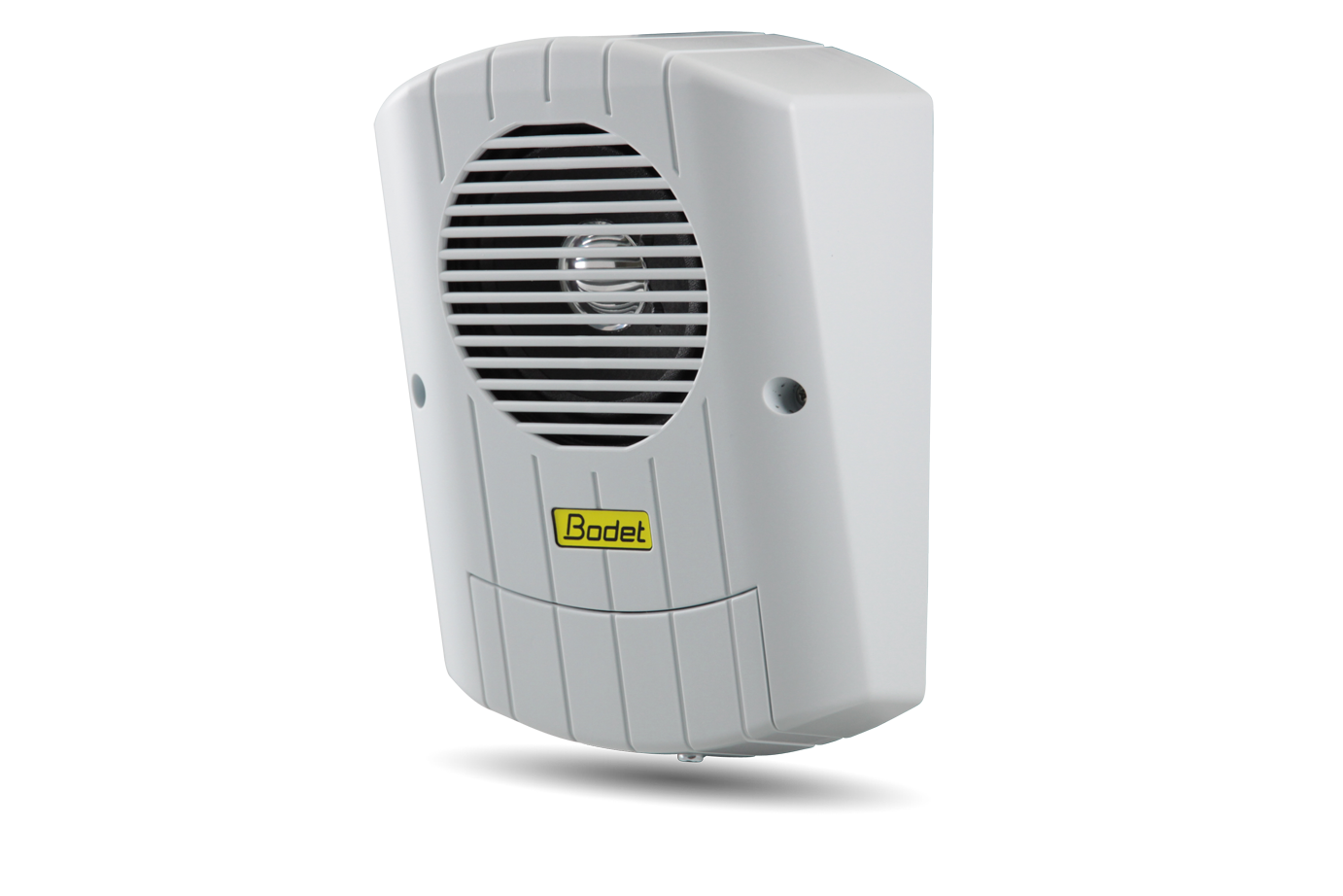 |
Melodys wireless flashIf the flash is programmed in the same zone, it will flash at the same time as the loudspeakers displays their message. The time can be programmed. The flash also has an outdoor version. |
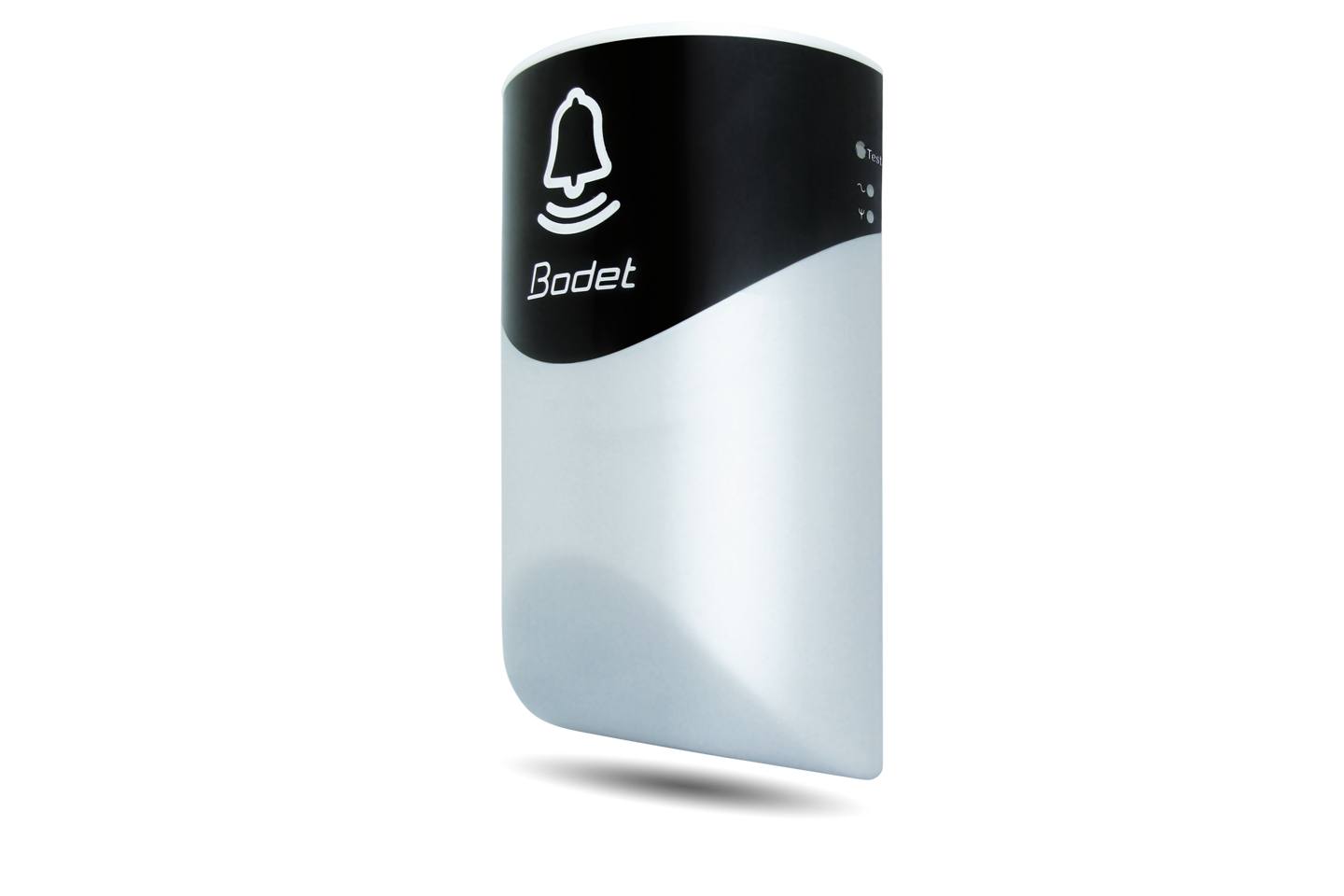 |
Wireless relay
The wireless relay is a small box with four relays, a DHF receiver, DIP switches to set the channel and a 230V connection. For what exactly can you use it? With the relays, for example, all lighting in the building can be switched off by programming a pulse at a specific time in the evening. Or to activate the fire evacuation alarm every year for an exercise. Or switch on and off air conditioners, activate heating, outdoor lighting, locks on fences. And properly many more other options we didn’t mention.
The DHF / RHF protocol is smart. The commands are sent from an hour in advance. So a communication failure cannot prevent the desired programs from being executed.
The alarm buttons are connected directly to the master clock and the function can be programmed via the software or on the master clock itself. When the alarm goes off, the alarm will sound and the flashes will flash in a red colour.
Time signalling system 2

The other Bodet Time system that we have tested consists of:
- A Sigma-MOD master clock
- Bodet Harmonys surface mounted loudspeaker
- Een Bodet Harmonys broadcasting microphone
- Bodet Harmonys flash
- Bodet Harmonys control box.
This time signalling system functions entirely over the network. The speakers, the broadcasting microphone, the flash and the control box are all powered by PoE. The programming of the Sigma-MOD master clock is almost identical to the Melodys system. There is an additional TAB sheet which showing all the devices in the network. Each device has its own web server with which the device is set up. Also with the Harmonys speaker, the tones and messages are stored in the internal memory of it. However, the messages can also be adjusted via the network; per loudspeaker or multiple (or all) speakers at the same time. Because the speakers are powered via the network, no 230V connection is required. In total 100 zones can be created with this system, which is quite a lot. And probably more than you will ever need. An outdoor version is also available here, and also indoor and outdoor flashes. The flashes function the same as the flashes of the Melodys system.
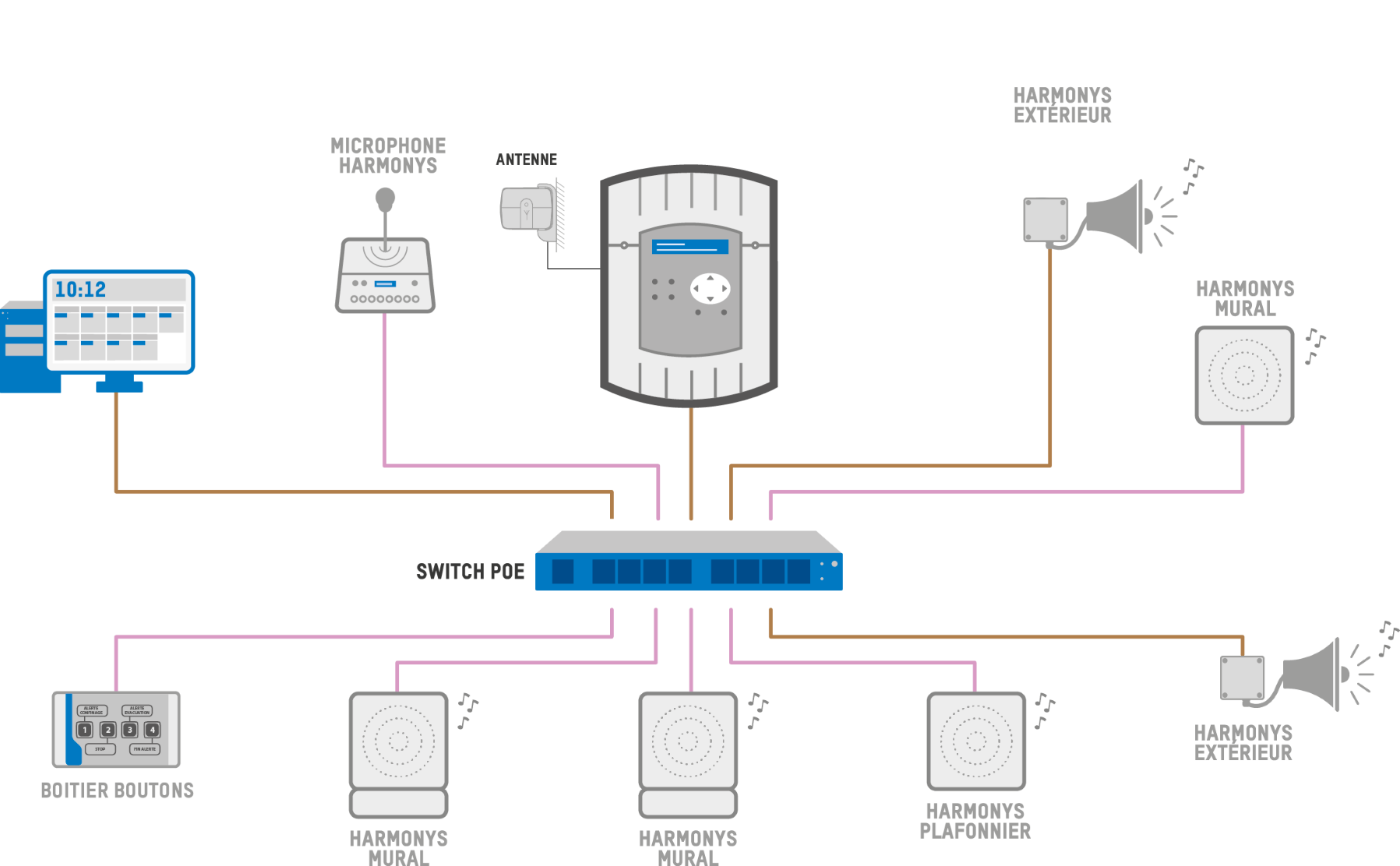
Example schedule of a time signalling system.
Harmonys surface mounted speakers
Bodet’s Harmonys surface mounted speakers are powered by PoE and therefore have a limited power (approx. 15W) available. Still, the sound from the speakers is loud and clear for a normal classroom. The Harmonys outdoor loudspeaker does have a 230V connection and a heavier amplifier.
Broadcasting microphone: pre-record messages or live broadcasting
| There are two models of broadcasting microphones; a broadcasting microphone with 15 and a broadcasting microphone with 8 zones buttons. We have tested the microphone with a 8 zones buttons. By selecting the zone it’s possible to make broadcasting in that specific zone (room). You can do this live via the microphone, you can also pre-record the message and listen at the message via the built-in speaker. If you want to edit the message, you can delete it and record it again. | 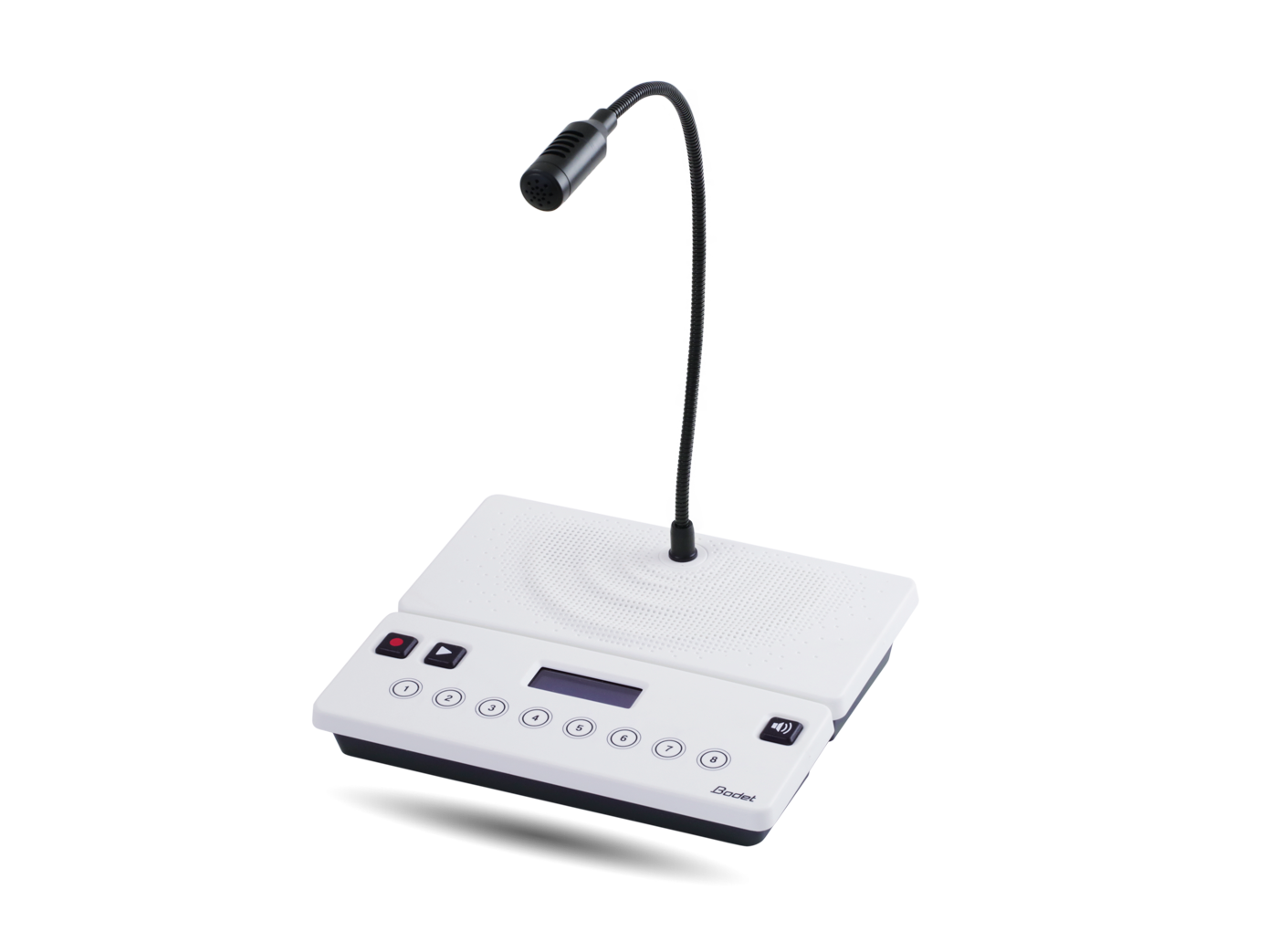 |
The built-in screen clearly indicates the status of the broadcast microphone. Before each message a ringtone will be heard. It can also be turned off ore adjusted. After the ringtone you can broadcast your message. There is a slight delay between the source and the speaker signal. In practice this will not cause any problems. The set looks good and is compact and the tested microphone sounds excellent. In our view, the gooseneck of the microphone could be a bit firmer. Experience teaches us that it isn’t always handled calmly.
The control box
| The control box consists of four push buttons. An expansion module is available to expand the control box to eight push buttons. With the buttons it’s possible to manually activate or stop messages, (de)activate relays and to (de)activate programs. The buttons can be freely programmed. The entire system also functions without the Sigma master clock. Without the master clock there isn’t no automatic time signalling. But with the control box you can manually activate ring tones. The broadcasting microphone is also still fully functional. | 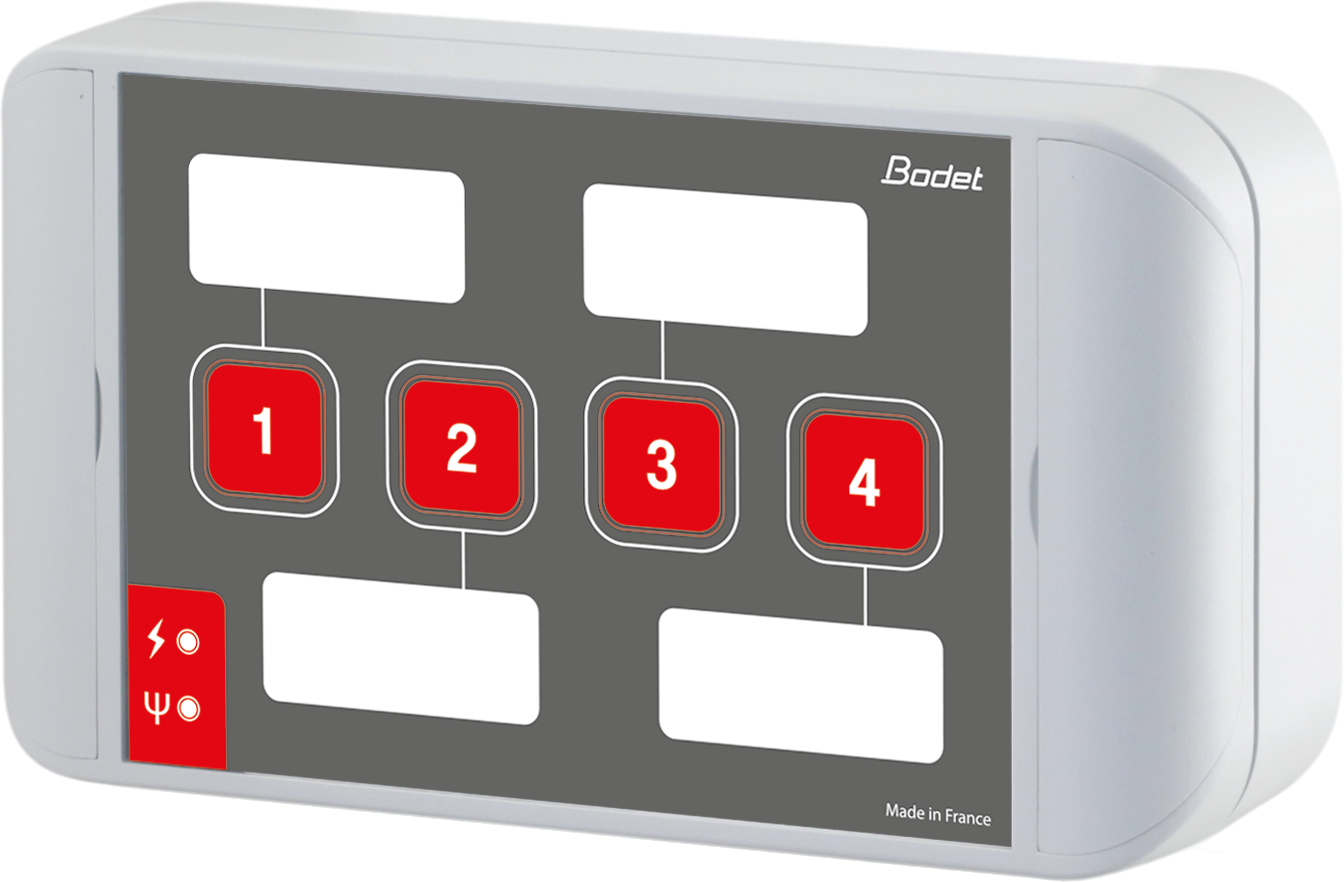 |
Harmonys line
Bodet Time also has a Harmonys line available. This module doesn’t have a built-in amplifier and speaker, but has a line output which can be used for a loop system or an existing speaker system. With the system software or the streaming app you can stream background music from a PC to the Harmonys system. This works great!
With the Talks app you can send messages using your mobile phone. Very handy, if you are not near a broadcasting microphone. The message will be first recorded and then sent to the system. The prerequisite is that the mobile phone and the Harmonys system are in the same network.
With the special Notify app it is possible to emulate the functions of the control box with a PC or mobile phone. Its operates the same as what can be done with the control box. This applications is also suitable for sending alarms or lock-down messages.
Lock-down module
A Lock-down module with remote control is available for both the Harmonys and the Melodys system from Bodet Time. This module works with LoRa (Long Range WiFi) technology and has a range of ~ 1 km. The alarms can be activated or deactivated with the remote control. The system is bi-directional; an LED on the transmitter indicates whether the signal has been received. Up to 48 transmitters can be paired to the Lock-down module.
The GSM module can also be used for this. When you call the GSM number, the alarm goes off and (up to six) other GSM devices are alerted by SMS. A mobile connection with SIM card is required. The IP system uses clocks that function over the network. These are the NTP and NTP-PoE models.
Conclusion
We discussed a lot about the Bodet Time Time signalling system and we still haven’t discussed everything. For example, the Sigma-C master clocks can control many more types of clocks, such as Impuls or AFNOR. In short, the possibilities and applications of the time signalling systems of Bodet Time are extensive and diverse.
Would you like to know what is the best solution for your situation for clocks or time signalling?
Contact us. Together we will determine the most suitable time signalling system for you. Our audio experts are here to help answering all your questions. Call Tau Audio Solutions: +31 (0) 50 549 90 90 or fill in the contact form.